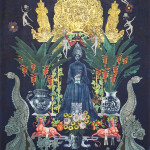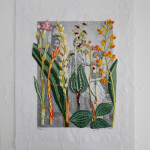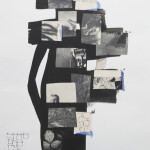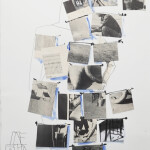PRESS RELEASE | E-CATALOGUE | EXHIBITION VIEW | CURATOR WALKTHROUGH
Agan Harahap, Budi Agung Kuswara, LULU LUTFI LABIBI, Mella Jaarsma, Octora, and TOTON
Curated by Tan Siuli
22 January – 7 March 2021 EXTENDED
Mizuma Gallery is pleased to announce Baroque Archipelago, a group exhibition curated by Tan Siuli, featuring six Indonesian artists and designers: Agan Harahap, Budi Agung Kuswara, LULU LUTFI LABIBI, Mella Jaarsma, Octora, and TOTON.
Baroque Archipelago brings contemporary art and fashion in conversation with one another, to illuminate parallel approaches in creation and exploration of current issues.
The exhibition title makes reference to both the baroque pearl as well as the Indonesian archipelago; the latter — spanning over 13,000 islands and a stunningly diverse spectrum of cultures, ethnicities and topographies — is compared to the former, an irregularly-shaped pearl celebrated precisely for its asymmetry and organic form. Embedded in the metaphor of the pearl is the process of its creation. It is formed when a foreign object is lodged within the interior of a mollusc; as a defensive mechanism, layers of nacre are secreted to envelop the external irritant, and these subsequently develop into a prized pearl. This process of formation may be likened to the Nusantara’s negotiation of the diverse and multi-faceted cultural landscape encompassed within its geographical and national boundaries, as well as with the foreign cultures that journeyed to its shores, in the process adopting and evolving these into something uniquely ‘Indonesian’.
Turning on ideas of adornment, desire and difference, Baroque Archipelago shines a spotlight on Indonesian creatives reinterpreting and reworking Indonesia’s rich traditions, and on the archipelago as an exemplar of the region’s syncretic culture, borrowing and adapting from diverse sources and cultures to evolve a distinct and unique sensibility. The notion of a syncretic identity (as opposed to a monolithic one) is also explored as a strategy of resistance against essentialist nationalism. In addition, the art and fashion creations on display question social and cultural norms and their evolution, especially as they relate to notions of identity, gender and power. In Indonesia, artists and designers often collaborate with each other and form a supportive, close-knit community; this exhibition is in many ways a celebration of these creative synergies and relationships.
About the Artists
 Agan Harahap (b. 1980, Jakarta, Indonesia) began his career as a painter and illustrator, and subsequently worked as a digital imaging artist and photographer for an Indonesian music publication. Today he is best known for his digitally manipulated images which are often disseminated through social media, harnessing the reach of this contemporary medium to comment on its potential and pitfalls, and on current issues.
Agan Harahap (b. 1980, Jakarta, Indonesia) began his career as a painter and illustrator, and subsequently worked as a digital imaging artist and photographer for an Indonesian music publication. Today he is best known for his digitally manipulated images which are often disseminated through social media, harnessing the reach of this contemporary medium to comment on its potential and pitfalls, and on current issues.
 Budi Agung Kuswara , or ‘Kabul’ (b. 1982, Bali, Indonesia) is the co-founder of Ketemu Project Space in Bali, an initiative that marries art collectivism and social enterprise. Trained in kamasan painting, Kabul retains the intricacy and delicate linework of this traditional art form in his contemporary works. His paintings celebrate the treasury of aesthetic and cultural influences on the Indonesian archipelago, marrying these baroque sensibilities with observations on social tensions and dynamics.
Budi Agung Kuswara , or ‘Kabul’ (b. 1982, Bali, Indonesia) is the co-founder of Ketemu Project Space in Bali, an initiative that marries art collectivism and social enterprise. Trained in kamasan painting, Kabul retains the intricacy and delicate linework of this traditional art form in his contemporary works. His paintings celebrate the treasury of aesthetic and cultural influences on the Indonesian archipelago, marrying these baroque sensibilities with observations on social tensions and dynamics.
 Indonesian designer LULU LUTFI LABIBI’s eponymous label was launched in 2012, and celebrates the beauty of traditional textiles such as lurik, which has become a signature in the label’s collections. The Yogyakarta-based designer has revolutionised this once-overlooked fabric by incorporating it into fluid, draped garments that reference silhouettes of Asian dress whilst embracing a wabi-sabi aesthetic.
Indonesian designer LULU LUTFI LABIBI’s eponymous label was launched in 2012, and celebrates the beauty of traditional textiles such as lurik, which has become a signature in the label’s collections. The Yogyakarta-based designer has revolutionised this once-overlooked fabric by incorporating it into fluid, draped garments that reference silhouettes of Asian dress whilst embracing a wabi-sabi aesthetic.
 Mella Jaarsma (b. 1960, Emmeloord, The Netherlands) is the co-founder of Cemeti Art House, one of Indonesia’s foremost contemporary art institutions. Her artistic practice revolves around the body and its coverings as powerful signifiers of identity and its social and cultural politics. Her work often employs materials such as animal skins and horns – items charged with metaphoric potencies of race, human nature, sexuality, beliefs and origins.
Mella Jaarsma (b. 1960, Emmeloord, The Netherlands) is the co-founder of Cemeti Art House, one of Indonesia’s foremost contemporary art institutions. Her artistic practice revolves around the body and its coverings as powerful signifiers of identity and its social and cultural politics. Her work often employs materials such as animal skins and horns – items charged with metaphoric potencies of race, human nature, sexuality, beliefs and origins.
 Octora (b. 1982, Bandung, Indonesia) adopts a multi-disciplinary approach to her art-making, investigating the intersections between image, official history and collective memory. Her interest in clothing and covering as modes of power and dissimulation has been an abiding one, manifesting in her exploration of dress and accoutrement in Indonesia.
Octora (b. 1982, Bandung, Indonesia) adopts a multi-disciplinary approach to her art-making, investigating the intersections between image, official history and collective memory. Her interest in clothing and covering as modes of power and dissimulation has been an abiding one, manifesting in her exploration of dress and accoutrement in Indonesia.
 Founded in 2012 by Toton Januar and Haryo Balitar, TOTON is a contemporary womenswear label that explores Indonesia’s natural beauty and diverse culture with modern reinterpretations, celebrating heritage while deconstructing traditions for a new approach. The label draws on artisanal techniques traditionally used for folk and ceremonial costumes, rethinking and reworking these in contemporary iterations of ethnic garments.
Founded in 2012 by Toton Januar and Haryo Balitar, TOTON is a contemporary womenswear label that explores Indonesia’s natural beauty and diverse culture with modern reinterpretations, celebrating heritage while deconstructing traditions for a new approach. The label draws on artisanal techniques traditionally used for folk and ceremonial costumes, rethinking and reworking these in contemporary iterations of ethnic garments.
About the Curator
 Tan Siuli has over a decade of curatorial experience with a focus on contemporary art from Southeast Asia. Her exhibition projects include two editions of the Singapore Biennale (2013 and 2016), inter-institutional traveling exhibitions, as well as mentoring and commissioning platforms such as the President’s Young Talents exhibition series. She has also lectured on Museum-based learning and Southeast Asian art history at institutes of higher learning such as the National Institute of Education as well as Lasalle College of the Arts. Her recent speaking engagements include presentations on Southeast Asian contemporary art at Frieze Academy London and Bloomberg’s Brilliant Ideas series.
Tan Siuli has over a decade of curatorial experience with a focus on contemporary art from Southeast Asia. Her exhibition projects include two editions of the Singapore Biennale (2013 and 2016), inter-institutional traveling exhibitions, as well as mentoring and commissioning platforms such as the President’s Young Talents exhibition series. She has also lectured on Museum-based learning and Southeast Asian art history at institutes of higher learning such as the National Institute of Education as well as Lasalle College of the Arts. Her recent speaking engagements include presentations on Southeast Asian contemporary art at Frieze Academy London and Bloomberg’s Brilliant Ideas series.





















